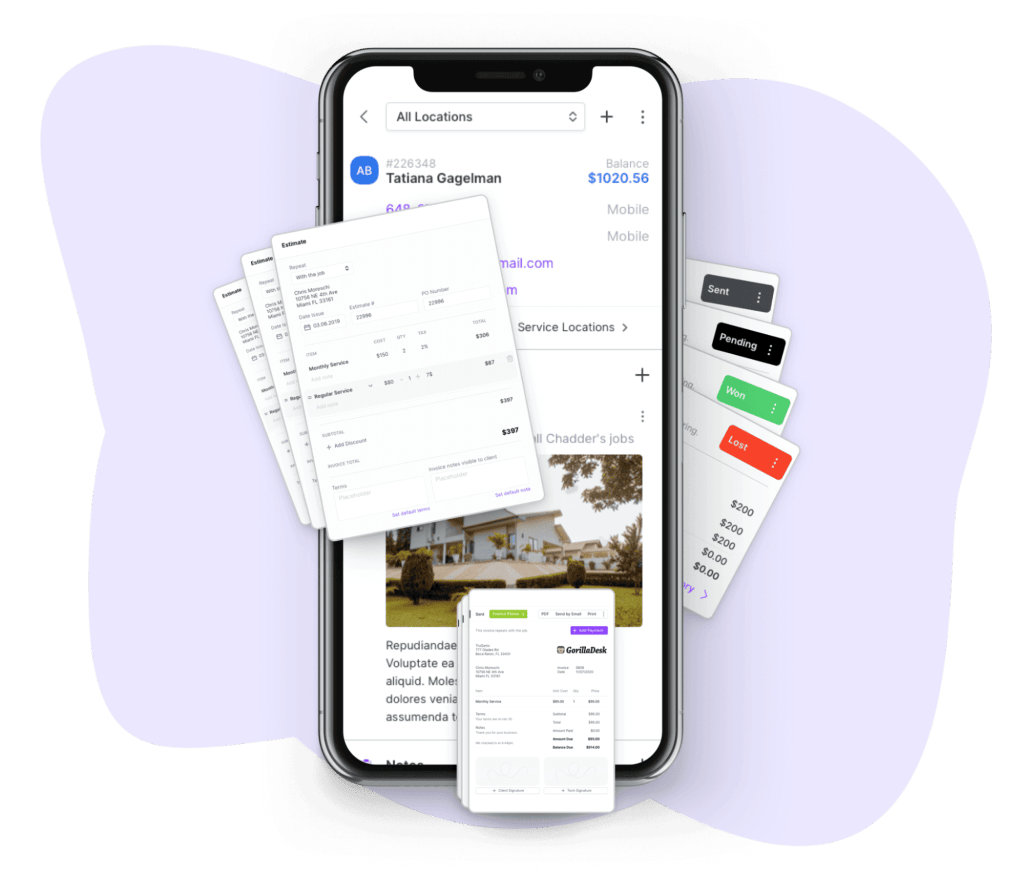Should you use door-to-door pest control sales to grow your business?
GorillaDesk Staff

Looking for ways to increase your pest control sales? You might be considering door-to-door sales as an “easy” way to gain more customers. After all, 20% of Americans still make purchases through door-to-door sales.
Door knocking, however, isn’t always the most efficient use of your time or resources. Your success rate may not make it worth it, and door-to-door pest control sales may have long-term repercussions, like poor customer retention, which can set your business back.make purchases through door-to-door sales.
That’s not to say that going door to door is never an effective pest control marketing tactic. Let’s dive into the pros and cons of pitching your business at a customer’s front door, plus ways you can efficiently implement door-to-door pest control sales—and when it’s most beneficial to do so.
The pros of door-to-door pest control sales
Selling your pest control services by going door to door gives you a chance to meet customers face to face along with these other benefits:
Personalized approach
Meeting customers in person gives you a chance to build rapport and a personal relationship. It’s also a great way to nurture trust in your business—as long as you’ve trained your sales team to actively listen and address customers’ objections.
By listening to customer needs, concerns, and questions, door-to-door salespeople can tailor their pitch to show how your pest control business can potentially solve customers’ problems. This shows your company genuinely cares about its customers rather than just making a sale.
Targeted marketing
Door-to-door sales give you a chance to market your pest control management services in new areas. Now you can expand your service area to neighborhoods that may not have heard about your business otherwise.
It’s also a way to target specific demographics. You can pick certain neighborhoods to target based on the types of homes or residents. For example, some businesses may focus on neighborhoods with larger homes, while others may focus on neighborhoods where families with children live.
Increased brand awareness
Having salespeople wearing branded uniforms along with branded vehicles visible in neighborhoods increases awareness of your pest control brand.
Additionally, positive interactions with salespeople and technicians can lead to recommendations. A family that has a great experience with your pest control company might mention your brand to their friends and neighbors, which could gain you additional business through referrals.
On-the-spot sales
Engaging with customers face to face gives salespeople a chance to close a sale on the spot.
But while this can lead to higher conversion rates compared to other marketing channels like email and search engine optimization (SEO), don’t forget that some customers may feel pressured to sign up—or worse, tricked—which could lead to poor reviews and unhappy customers in the future.
The cons of door-to-door sales
While some online gurus make door-to-door sales sound like a magical way to increase your sales, they’re likely skipping over these downsides:
Negative perception
What’s your first instinct when you hear the doorbell ring but don’t recognize the person at the door?
Most of us don’t answer the door and pretend not to be home. Those of us who do open the door tend to start the conversation in defensive mode—and some may even be angry about the disruption. Others may be concerned about potential scams.
There’s also the stereotype that door-to-door salesmen are pushy and aggressive. These negative perceptions make it difficult for salespeople to create a relationship built on trust and credibility.
High rejection rates
No matter how skilled your sales reps are, they’ll still hear “No” more often than “Yes.” Sales software notes that the average conversion rate for door-to-door sales is 2%. And even if you spend countless hours training your salespeople to be more efficient and successful at pitching your pest-prevention services, they’ll still hear a lot of rejections.
Cost and resource-intensive
Speaking of training your sales representatives, door-to-door sales requires a large investment of time, money, and manpower.
- Employees: You’ll need a dedicated team of sales reps who require training, salaries, and benefits.
- Travel: Your sales team needs a way to get to new neighborhoods, which can add up in terms of gas or mileage reimbursement, vehicle maintenance, and even parking fees.
- Door-to-door sales training: You’ll need to train your sales team on the best ways to handle customer objections, develop trust, and other sales tactics.
- Reputation: You may see an increase in complaints or negative reviews due to door-to-door sales, which means you’ll need more resources to manage your reputation.
Some larger companies outsource door-to-door sales, but this also adds up fast. You’ll likely pay a large percentage of the contract value to have a third-party knock on doors for you.
Finally, door-to-door sales may come with an opportunity cost. The time, money, and employees you’re using to go door to door could be invested in other approaches that lead to better-qualified pest control leads.
Should you add door-to-door pest control sales to your business model?
It’s easy to get caught up in the excitement when you see other pest control companies attribute their success and quick growth to door-to-door sales. But take these successes with a grain of salt, and remember that other marketing tactics often have better results.
Pest Control Technology’s 2023 Marketing Benchmark Report notes that organic search and local search ads are the most cost-effective lead generation channels for pest control companies.
This makes sense considering that 75% of consumers search Google before scheduling an appointment for pest control services. Better yet, those consumers are ready to sign up for pest control services—but door-to-door sales often reach customers when they aren’t in buying mode.
However, door-to-door pest control sales make sense in certain situations. Let’s say you’re trying to expand your service area or just started a new pest control business and need a way to create awareness for your brand. Knocking on doors gives your sales team an opportunity to educate potential customers about your brand and the value you provide.
Door-to-door sales can also be an effective way to reach customers during particularly troublesome pest seasons, like mosquitoes in the summer or rodents in the winter. Going door-to-door after heavy storms that could speed up pest population growth also helps you reach new customers before their pest problems get out of control.
Whether you choose to use door-to-door sales techniques or not, aim to have what Rick Stewart, owner of Stewart’s Lawn Care & Pest Control, calls a service culture instead of a sales culture. “With service culture, customer retention and a good reputation drive the business forward; they are not problem areas that need to be offset by increased sales,” he writes.
How to build door-to-door sales into your business model
Still think selling door to door is right for your business? Here are some key steps for adding this sales technique and improving your profit margin:
Research the market
Take a look at your local market to identify neighborhoods that might have pest issues. Consider things like:
- Housing density
- Age of homes
- Family size
- Geographic factors like proximity to water
This lets you map out different areas to focus your door-to-door sales and prioritize them based on whether customers there are likely to convert.
Market research can also help you pinpoint specific customer needs and potential objections that you can address in your sales script. It’s also a critical first step for setting competitive pest control prices—and competitive prices make it easier for your sales reps to close a sale.
Create a sales script
Creating a sales script gives your salespeople a starting point for creating the best possible first impression with customers. A good script outlines a sales pitch that avoids using high-pressure tactics and focuses on building rapport instead.
If you don’t already have a sales script, create one that includes the following elements to keep the conversation focused on the customer:
- Demonstrate understanding of the customer’s needs
- Introduce your business by explaining how it addresses those needs
- Present a personalized offer and outline the benefits to the individual customer
Remember to leave space in your script where sales reps can ask and answer customer questions.
Train your salespeople
Along with assets like a script and sales playbook, your sales team also needs strong training on your services, core sales techniques, soft skills, and objection handling. If you’re unsure where to start, use AI tools like ChatGPT for presentations and to generate ideas for effective training materials to support your team.
If you don’t have time to train salespeople yourself, there are specialized door-to-door sales courses you can enroll your team in:
- D2D Experts
- Udemy
- That Knock Life
There may also be smaller, local courses near you. However, if you operate a pest control franchise, your parent company likely offers specialty training and resources.
Use CRM software
GorillaDesk includes a CRM that lets you search and filter customer history to create personalized sales pitches and offers (Source)
Customer relationship management (CRM) software can improve the efficiency of your door-to-door sales. It also provides support for your technicians to give the best customer service possible as well as ask for customer feedback, both of which can positively impact your referral and retention rates. Here’s how:
- Market and lead research: A CRM stores all the valuable data you’ve gathered with potential and current customers, including past interactions. This data helps you target new opportunities and customize your sales pitch and offers to best address customer needs.
- Route planning: You can use a CRM like GorillaDesk to plan sales routes, ensuring there’s no overlap when your team goes door to door. This software can also optimize your sales routes to improve fuel efficiency and reduce travel time.
- Digital estimates: CRMs like GorillaDesk enable your sales team to create estimates in the field, which can speed up the process of signing up a customer for service.
Using a CRM also helps you follow up with appointment reminders or for ratings and reviews. For example, GorillaDesk has automated emails that request a rating and review from customers. When a customer chooses to rate or review your pest control services, they’re taken to your profile on Google My Business.
Mind local regulations
Some cities or neighborhoods may restrict door-to-door sales to certain hours or require a permit. Some areas also enforce “No soliciting” signs posted by private homeowners. For example, Manhattan Beach notes that if a residence has a sign posted, “it’s illegal to solicit, regardless of whether or not the solicitors have a permit.”
Before you send out your sales team, research the areas you’re planning to canvass to make sure you’re legally compliant with local laws and codes.
5 alternatives to door-to-door pest control sales
These alternatives to door-to-door sales are proven to attract more leads and convert more customers:
1. Online marketing
Creating an online presence is a key step for helping potential customers find your business. Start with a professional pest control website where you can collect leads and provide customers with more information about your business.
Optimizing your website for SEO also improves the chances that your ideal customer can find you online. Pay-per-click (PPC) advertising and social media can also catch your customers’ attention and lead them to your site or encourage them to call your business to learn more.
2. Referral programs
When you’re focused on providing the best possible service to your customers, it’s natural to earn business through referrals. You can even encourage customers to do this (and reward them, too) by creating a referral program.
3. Direct mail
No, direct mail isn’t dead—and it’s a great way to reach your target market. Send postcards, flyers, or brochures to neighborhoods where you hope to expand your business, and include a phone number and your website URL so customers can learn more about your business.
4. Email campaigns
Email marketing is another effective way to reach potential customers and even nurture existing customer relationships. You can collect potential customers’ emails in a number of ways, such as at community events and through forms on your website.
It’s best to then segment your list of customer emails by information like area, household size, and current needs. Then, follow up by providing value with seasonal promotions and special offers.
5. Cross-promotions and community events
Showing up at community events and partnering with complementary businesses are other ways to shine the spotlight on your company. You might even sponsor these same events or youth sports teams and school programs to show you’re invested in your local neighborhood.
GorillaDesk helps you build lasting customer relationships
Door-to-door sales has its place in the pest control industry. Even if it’s not the right move for your business now, it could be later down the road. Choosing a pest control software that’s built to grow with your business is important for maintaining efficiency, no matter how you make a sale.
GorillaDesk comes packed with features designed to help you deliver high-quality customer service that keeps your customers coming back. These include a CRM, routing optimization, technician scheduling, a customer portal, and automated follow-ups and customer communication. To find out how GorillaDesk can improve your customer service and efficiency, sign up for a 14-day free trial now.
Other posts to check out
Make the move from paper to digital: A step-by-step guide for field service pros
If your field service business is still doing business on paper, it’s time to make a change. Here’s how to find success with a move to digital.
Pest control marketing: Let’s make that phone ring
With so many other local pest control companies making competition tight, keeping that phone ringing with new customers may not feel as easy as you thought. To keep your pest control business growing takes marketing know-how. Here are our best tips.
How to get more positive customer feedback
Customers trust online reviews just as much as word of mouth from friends and family. The truth is: Online reviews can make or break your local services business. Here’s how to build that glowing reputation your service deserves.
Tree service marketing: 11+ ideas to drive more customers in 2025
Drive more leads with our ultimate tree service marketing guide! Discover 11+ proven strategies to grow your business and attract the right customers.
How to start a tree service business in 2025
Learn how to start a tree service business with step-by-step guidance on planning, licensing, equipment, marketing, safety, and scaling your company.
Landscaping services list: What to offer your customers
Discover the top landscaping services to offer for maximum profit. From design to maintenance, expand your business with our comprehensive landscaping services list.
Transform your business
Try it free for 14 days. No credit card required. Instant setup.
★★★★★
We will be customers for life
“I can not say enough good things about GorillaDesk it saves us so much time and money. The customer service is the best. I would recommend GorillaDesk to anyone no matter what industry. I trained my employee in 5 minutes on how to use it. We will be customers for life.”

Ryan Sullivan
Business Owner
Ready to Get Started?
Get all our amazing features and top-rated support, with no credit card required.







